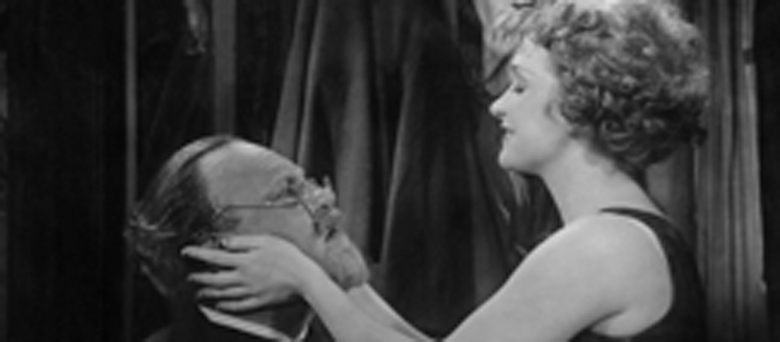Reviews
Josef von Sternberg
Germany, 1930
Credits
Review by Cullen Gallagher
Posted on 17 August 2010
Source Kino International DVD
Though the femme fatale is most immediately associated with Hollywood’s film noir of the 1940s and 1950s, its rich lineage goes much further back into film history. There was Theda Bara, Pola Negri, and Louise Brooks (to name just a few), but none were as lovely or as dangerous as Marlene Dietrich. Her breakthrough role as the seductive cabaret performer Lola-Lola in Josef von Sternberg’s The Blue Angel embodies many of the characteristics that would come to define her inimitable, unforgettable screen presence throughout her career: a tough, resilient attitude; a raw, unashamed sexuality; an unimpeachable intelligence; and—let’s face it—a ravishing pair of gams that would make history and forever be a part of Dietrich’s image. As Charles Silver wrote in his book-length monograph on the actress, Marlene Dietrich, “Lola-Lola is like no femme fatale the screen had yet witnessed.” After Dietrich, the screen would never be the same again.
Based on Heinrich Mann’s novel Professor Unrath and retitled The Blue Angel, the movie’s intended star was not Dietrich but instead Emil Jannings. At the time, he was one of Germany’s most revered actors of stage and screen. Even today, several of his roles are among the most iconic of German cinema: Louis VX in Ernst Lubitsch’s Madame DuBarry (1919); the title role in Dimitri Buchowetzki’s Othello (1922); the tragic trapeze artist from E.A. Dupont’s Variety (1925); and three films with F.W. Murnau, including playing the title character in Tartuffe (1925), Mephisto in Faust (1926) and, most famously, the doorman who falls from grace in The Last Laugh (1924). Just as Dietrich’s bodily gusto made her perfect for Lola-Lola, so too did Jannings’ esteemed history make him ideal for his character.
Jannings plays the aging, unmarried Professor Immanuel Rath, whose unruly students have nicknamed him Professor “Unrath” (“Garbage,” in German). When he catches his students fawning over photographs of the scantily clad Lola-Lola while in class, Rath doesn’t expect that his quiet, respectable, staid life is about to go into a paranoid, sexually charged tailspin. Barging into the local club The Blue Angel intending to denounce the scantily clad performer, Rath instead finds himself simultaneously charmed, embarrassed, and seduced by Lola-Lola. When a fight he causes arouses the attention of the police, Rath’s relationship with Lola-Lola can no longer be kept a secret. It costs Rath his job, but that is only the beginning of the price he pays for following his desires. Marrying Lola-Lola, Rath joins up with her traveling troupe and starts his long descent into the proverbial gutter.
Von Sternberg indulges in his characteristic lurid, debauched pleasures throughout The Blue Angel, but particularly in the bar scenes. The crowds are rowdy, the moustaches ample, and the garters generous. Dietrich’s casual air as she strips before the Professor and drops her panties into his palm is shocking not so much for what she reveals (though flesh is certainly plentiful) but for her frankness. She is as comfortable as she is confident about her sexuality, a rare combination not only for that time, but even now. The clothes might come off more easily in modern movies, but Dietrich’s sexuality was never so simple as just skin. Lola-Lola’s performance of “Falling in Love Again” is rife with her character’s complexities. Her indifferent posture (her white, top hat cocked and her hands clasped around her legs) and brash singing clash with the nostalgic melody and sentimental lyrics. Amidst her world-weariness there is a tinge of sweetness, as though the drunken crowds and life on the road hasn’t totally destroyed her spirit. As Charles Silver writes in his monograph, “The nuances of Dietrich’s performance bridge the gaps [in Lola-Lola’s character]… Aside from her extraordinary beauty, Dietrich brought to this conception her ironic intelligence, a quality that women of 1929 were not encouraged to display.”
The shifting of the title from Professer Unrath to The Blue Angel is significant. Jannings may have gotten top billing, but the movie’s soul belongs to Dietrich. We sympathize with his downfall much like in The Last Laugh, but there is no pity for him like in Murnau’s film—he brought this upon himself. Von Sternberg takes great pleasure in watching Rath lose his humanity, and Jannings’ movements becoming increasingly grave as though his characters’ lifeline is literally slowing down with every gesture. But while Lola-Lola may be the agent of his downfall, she is no mere Black Widow, preying on the male race one specimen at a time. Instead, what makes her character so lasting and so compelling is that she has what Rath lacks—self-awareness, self-acceptance, and self-preservation. Lola-Lola harbors no illusions about the world or herself, and there’s not an ounce of pity in her character. Just as her intelligence belies her age, his naivety belies his. Rath engages our sympathy, but Lola-Lola wins our respect.
Dietrich’s magnetism on-screen is unmistakable, and the inspired and fortuitous pairing of her and von Sternberg remains magical eight decades later. The elegant lighting and decadent costuming that would characterize their later collaborations may not be fully developed in The Blue Angel, but the signs of their challenging social and aesthetic ambitions are clear to see. The future held great things for the star and her director, and The Blue Angel was a promising first step.
We don’t do comments anymore, but you may contact us here or find us on Twitter or Facebook.



